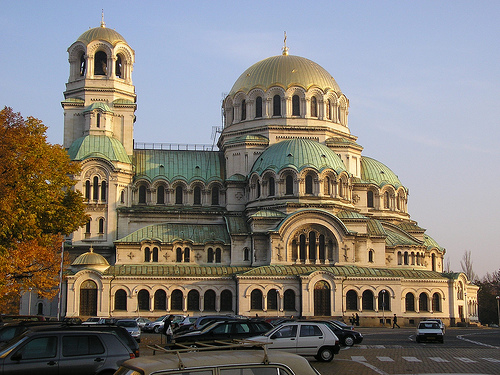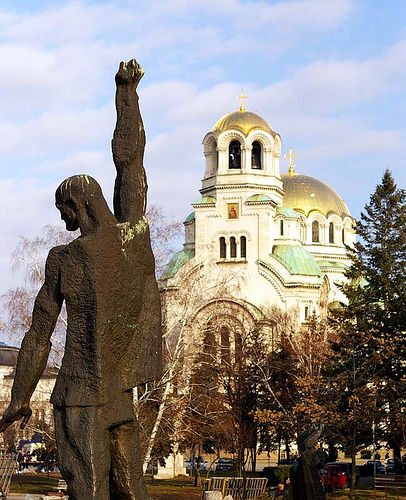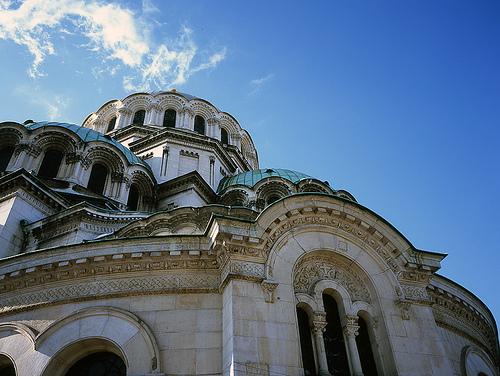 Photo: 82877821@N00
Photo: 82877821@N00
The first thing to notice is the impressive brilliance of the golden domes. But that` s not all it has to show, since the temple is a modern Tower of Babel, built with pieces from all around the world.
Or at least, the whole of Europe would work in 1904 when a construction on a project of the Russian architect Alexander Pomerantsev began. The facing/ paneling was started by Italian stonemasons, but finished by Bulgarians. Murals and preparation of the tempera paints for them were made under the strict supervision of Professor Kiselyov and many Russian artists participated in their creation. Tachev and Mikhailov, Bulgarian decorators, designed the interior. Wooden ornaments were made under the guidance of Professor Perminov, and the paint job was entrusted to the Austrian master Lester.
Colored Italian marble, Brazilian onyx, alabaster and other expensive and exotic materials were sent off from all the ends of the world toward the capital of the young Principality to be embedded in the huge vessel of the cruciform basilica. The twelve bells of the temple were cast and delivered from Moscow, the marble sculpture – from Berlin, wooden doors made in Austria by Karl Bemberg, mosaics supplied from Venice, chandeliers from Munich.
The main dome is 45 meters high. In a circle, around the dome, with thin gold letters is inscribed The Lord’s prayer. Covering an area of 3170 m2, the church can hold 5000 people. The bell tower is nearly 53 meters high and has 12 bells – the largest weighing 12 tons and the smallest – 10 kg. Only the hand of the figure, drawn on the largest dome, is 40 meters in length. The temple was declared a cultural monument in 1924. During World War I its name was briefly changed to St. Cyril and Methodius because of the rivalry between Russia and Bulgaria.

Photo:atbaker
This is likely to be heard from any travel guide and is all very impressive. But then you will forget it. This is all just stones, iron and wood.
But together, they become a masterpiece of post-liberation work. In variety and diversity, in the specific attention to detail, in the harmony between canon and unbridled imagination of the artist, in the grand scope of the project — all of this expresses its true value. And it shows in how it affects the mindful visitor.
The outside of Alexander Nevsky Cathedral is undoubtedly beautiful and impressive owing to its size and the twinkle of the domes like distant suns. But its real force is behind the massive wooden doors — in the twilight of the candles. As large as it seems from the outside, when you first step in, you are likely to feel like Alice having just tested the bottle of shrinking syrum. You might really believe you are in Wonderland.
Standing on the porch, you might find the counters where candles are sold a bit curious. Thin, smiling ladies sitting comfortably in wheeled, wooden boxes! Yes, incredible as it is, if you examine your surroundings, you will see that they really resemble the old shop where your grandmother kept her crystal glasses!
But more wonders lie ahead. The hall proceed with haphazardly, rather like the thronehall of a palace from a fairy tale. Only, it is much darker and smells of incense and candles. You can lose a whole hour in the examination of one or another biblical scene, painted so realistically that they appear to be happening no as you peer through a window to watch them.
You are likely to stop, intrigued, by the ornate marble thrones before the high altar. For those who do not know – they were intended for King Ferdinad, Queen Johanna and their heir.
 Photo: yovko
Photo: yovko
Be careful, because the world might spin before your eyes while viewing pictures of the domes. The Memorial may not be the Sistine Chapel, but it’ll take your breath away. As bleak as it is near the floor, it becomes bright and spacious at the painted-sky ceiling.
By the end, the sense of immensity will probably have you feeling a little tired and dizzy. However, if you still have the energy and desire, you might visit the crypt. It is opposite of the main complex – like a set of catacombs, but with whitewashed walls. There you will find an interesting exhibition (especially if you have an understanding religious art).











2 comments so far ↓
Nobody has commented yet. Be the first!
Comment